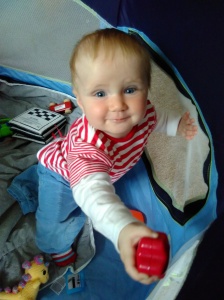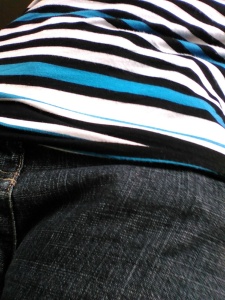I’m back after a long hiatus, with a new baby and (at least some of) the same old struggles. Big Bobbin is now 6 (six!) years old (how did that happen?) and New Moo is 9 months.
While I was out shopping this morning, the woman at the checkout in the charity shop said “hello, little man!” to New Moo. I gave the lady a friendly smile and said “little girl, actually!” and tried to get Moo to wave hello. However, any further baby-chat was immediately lost in a tide of nervous apologies from the checkout lady: “Oooh, I’m sorry! Little girl! It’s so hard to tell when they’re that age! It’s cos she’s got short hair, ooh I am sorry, of course she’s a girl, isn’t she lovely…” and so on, while I attempted to interject reassurances: “It’s OK! Really, it’s fine! I’m not bothered! It is hard to tell! She doesn’t mind what you call her!” … and so on.
The thing is, I genuinely don’t mind if you guess my baby’s sex and guess wrongly. You’ve got approximately a 1 in 2 chance of being right, it’s fair enough to play those odds; but if you get it wrong, the thing to do is so “oh sorry!” or even just “ah OK!” and then MOVE ON. It doesn’t matter. Either you’re going to talk to me again, in which case you’ve got a chance to get it right next time; or you’re not, in which case it really doesn’t matter. (I also don’t mind if you don’t guess. Why do you need to guess?)
“If it doesn’t matter,” you may ask, “why bother correcting them at all?” Good question. I don’t always bother. However, these incidents are part of a bigger picture. I think there are three main reasons why people guess “boy” for my baby (and for babies in general):
1. Male is the default. For everything. For example, listen to adults talking with kids about their stuffed animals, or about pictures of animals in books, and they will all be addressed as “he” by default (“look at the monkey, what’s he doing?” etc). Even I find myself falling into this habit/trap, despite conscious efforts to vary it (“what’s she doing?” or “what’s the monkey doing?”). Same deal with animated trains, trucks, dancing teapots, whatever: all male unless proven female. So it’s no surprise that all babies are “he” unless there are obvious femaleness markers, which brings me to…
2. Clothes. You can’t tell a baby’s sex by looking at its face. They basically all have short hair at 9 months (and obviously hair length is not a reliable indicator of biological sex anyway, yada yada). If you want to make absolutely sure people read a baby as female, you dress it in pink dresses and high heels, and if necessary literally glue a bow to its head (I wish I was making this up). The corollary of this is the assumption that if you don’t do these things, it must be a boy, because why would you let your little girl be misgendered when the tools exist to prevent it?
Here’s what Moo was wearing at the time:
And for comparison, here’s the colours I was wearing:
All her clothes are hand-me-downs or bought from charity shops; she basically wears whatever fits her and is clean and weather-appropriate at the time. I like bright colours, so she’s more likely to be wearing brights than pastels, but really, I’ll take “fits and doesn’t smell of wee” over more subtle aesthetic choices. The same applies for my clothes: what’s clean, what fits, most likely to wear black or bright colours. The difference is that there’s basically no chance I will be read as male, even in gender-neutral jeans and tshirt: I’m 5’1″ with a waist-length pigtail and a 40C chest. I wouldn’t mind people guessing wrongly or asking me about my gender, but I would be quite surprised! But with a baby there are no such obvious markers, so…
3. The safest way to get it wrong is to guess “boy”, because of a probably mostly subconscious understanding that maleness is the ‘better’ option so it would be much worse to misread a boy as a girl than the reverse (there’s a whole raft of problems and assumptions which I don’t really have time/space to unpack here, but to put it briefly, would you rather risk calling someone else’s kid a “tomboy” or a “sissy”?).
Given all that, when I can be bothered – or when I just forget that it’s easier to stay quiet – I want to try, gently, to challenge those assumptions a little bit.
*
A few minutes later, in another shop, an old man said “Hello, little fellow! That’s a nice smile!” to Moo. I smiled back and carried on with my shopping.



Welcome back! On behalf of the Internet: glad you’ve returned!